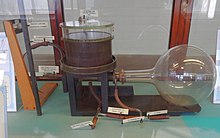Charles Thomson Rees Wilson
Charles Thomson Rees Wilson Owens College | |
|---|---|
| Known for | |
| Awards |
|
| Scientific career | |
| Fields | Cecil Frank Powell |
Charles Thomson Rees Wilson,
Education and early life
Wilson was born in the parish of Glencorse, Midlothian to Annie Clark Harper and John Wilson, a sheep farmer. After his father died in 1873, he moved with his family to Manchester. With financial support from his step-brother he studied biology at Owens College, now the University of Manchester, with the intent of becoming a doctor. In 1887, he graduated from the college with a BSc. He won a scholarship to attend Sidney Sussex College, Cambridge, where he became interested in physics and chemistry. In 1892 he received 1st class honours in both parts of the Natural Science Tripos.[4][5][6]
Career
He became particularly interested in
Wilson was made Fellow of Sidney Sussex College, and University Lecturer and Demonstrator in 1900.[3] He was known by some as a poor lecturer, due to a pronounced stutter,[10] but he did teach a course on atmospheric electricity as a visiting lecturer at Imperial College London.[11]
Contributions
The invention of the cloud chamber was by far Wilson's signature accomplishment, earning him the Nobel Prize for Physics in 1927.[6] The Cavendish laboratory praised him for the creation of "a novel and striking method of investigating the properties of ionized gases".[12] The cloud chamber allowed huge experimental leaps forward in the study of subatomic particles and the field of particle physics, generally. Some have credited Wilson with making the study of particles possible at all.[8]

Wilson published numerous papers on meteorology and physics, on topics including X-rays,[13] ionization,[14] thundercloud formation,[15] and other meteorological events.[8] Wilson may also have observed a sprite in 1924, 65 years before their official discovery.[16] Weather was a focus of his work throughout his career, from his early observations at Ben Nevis to his final paper, on thunderclouds.[17][15]
Method
Retrospectively, Wilson's experimental method has received some attention from scholars.
In a period of scientific inquiry characterized by a divide between "analytical" and "morphological" scientists, Wilson's method of inquiry represented a hybrid. While some scientists believed phenomena should be observed in pure nature, others proposed laboratory-controlled experiments as the premier method for inquiry. Wilson used a combination of methods in his experiments and investigations.[18] Wilson's work "made things visible whose properties had only previously been deduced indirectly".[8]
He has been called "almost the last of the great individual experimenters in physics".[10] He used his cloud chamber in various ways to demonstrate the operating principles of things like subatomic particles and X-rays.[13][14] But his primary interest, and the subject of the bulk of his papers, was meteorology.[18]
Awards, honours and legacy
Wilson was elected a


For the invention of the cloud chamber he received the Nobel Prize in Physics in 1927.[8][6] He shared this prize with the American physicist Arthur Compton, rewarded for his work on the particle nature of radiation.[17] Despite Wilson's great contribution to particle physics, he remained interested in atmospheric physics, specifically atmospheric electricity, for his entire career.[19][20] For example, his last research paper, published in 1956 when he was in his late eighties (at that time he was the oldest FRS to publish a paper in the Royal Society's journals), was on atmospheric electricity.[15]
The
The archives of C.T.R. Wilson are maintained by the Archives of the University of Glasgow.[24]
In 2012, the Royal Society of Edinburgh held a meeting in honour of Wilson, the "Great Scottish Physicist".[20]
Personal life
In 1908, Wilson married Jessie Fraser, the daughter of a
References
- ^ S2CID 73384198.
- ISBN 0-385-17771-2.
- ^ a b Charles Thomson Rees Wilson's biography
- ^ doi:10.1093/ref:odnb/36950. Retrieved 28 January 2017. (Subscription or UK public library membershiprequired.)
- ^ "Wilson, Charles Thomson Rees (WL888CT)". A Cambridge Alumni Database. University of Cambridge.
- ^ a b c "C.T.R. Wilson - Biographical". Nobelprize.org. Nobel Media AB. Retrieved 28 January 2017.
- ISSN 2156-2202.
- ^ a b c d e Brocklehurst, Steven (7 December 2012). "Charles Thomson Rees Wilson: The man who made clouds". BBC News. Retrieved 8 June 2017.
- ^ Phillipson, Tacye (December 2016). "Surviving Apparatus Showing the Early Development of the Cloud Chamber". Bulletin of the Scientific Instrument Society.
- ^ .
- ISSN 0043-1656.
- .
- ^ ISSN 1364-5021.
- ^ ISSN 1364-5021.
- ^ S2CID 98637297.
- ^ a b Bowler, Sue (7 December 2012). "C T R Wilson, a Great Scottish Physicist: His Life, Work and Legacy" (PDF).
- ^ .
- ^ ISBN 9780521337687.
- S2CID 2428610.
- ^ ISSN 1477-8696.
- ^ "Planetary Names: Crater, craters: Wilson on Moon". planetarynames.wr.usgs.gov. Retrieved 28 January 2017.
- .
- ^ "About | Wilson Society". www.srcf.ucam.org. Retrieved 28 January 2017.
- ^ "Papers of Charles Thomson Rees Wilson, 1869–1959, Nobel Prize winner and Professor of Natural Philosophy, University of Cambridge – Archives Hub". Retrieved 28 January 2017.
External links
 Media related to Charles Thomson Rees Wilson at Wikimedia Commons
Media related to Charles Thomson Rees Wilson at Wikimedia Commons- C.T.R. Wilson on Nobelprize.org
- The Papers of C. T. R. Wilson held at Churchill Archives Centre
